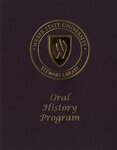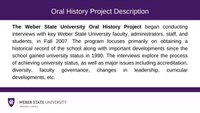| Title |
Zeveloff, Sam OH3_044 |
| Creator |
Weber State University, Stewart Library: Oral History Program |
| Contributors |
Zeveloff, Sam, Interviewee; Kenner, Marina, Interviewer; Stokes, Alexis, Video Technician |
| Collection Name |
Weber State University Oral Histories |
| Description |
The Weber State University Oral History Project begane conducting interviews with key Weber State University faculty, administrators, staff and students, in Fall 2007. The program focuses primarily on obtaining a historical record of the school along with importand developments since the school gained university status in 1990. The interviews explore the process of achieving university status, as well as major issues including accreditation, diversity, faculty governance, chagnes in leadership, curricular developments, etc. |
| Abstract |
The following is an oral history interview with Dr. Sam Zeveloff, conducted on June 23, 2021, in the Stewart Library, by Marina Kenner. In this interview, Sam discusses his life, his experiences, and his time serving as a professor of Zoology at Weber State University.; The following is a video clip of an oral history interview with Dr. Sam Zeveloff, conducted on June 23, 2021. In this video clip, Sam provides advice to students and the general public to follow their passions. |
| Image Captions |
Dr. Sam Zeveloff Circa 2018; Dr. Sam Zeveloff Circa 2018; Dr. Sam Zeveloff speaking to Marina Kenner and Alexis Stokes for his oral history interview |
| Subject |
Zoology; Zoology teachers; Mammalogy; Universities and colleges; College department heads; Universities and colleges--Faculty |
| Keywords |
Zoology professors; Mammalogy conservation; Distinguished professors |
| Digital Publisher |
Stewart Library, Weber State University, Ogden, Utah, USA |
| Date |
2021 |
| Date Digital |
2021 |
| Temporal Coverage |
1950; 1951; 1952; 1953; 1954; 1955; 1956; 1957; 1958; 1959; 1960; 1961; 1962; 1963; 1964; 1965; 1966; 1967; 1968; 1969; 1970; 1971; 1972; 1973; 1974; 1975; 1976; 1977; 1978; 1979; 1980; 1981; 1982; 1983; 1984; 1985; 1986; 1987; 1988; 1989; 1990; 1991; 1992; 1993; 1994; 1995; 1996; 1997; 1998; 1999; 2000; 2001; 2002; 2003; 2004; 2005; 2006; 2007; 2008; 2009; 2010; 2011; 2012; 2013; 2014; 2015; 2016; 2017; 2018; 2019; 2020; 2021 |
| Medium |
oral histories (literary genre) |
| Spatial Coverage |
Brooklyn, Kings, New York, United States, https://sws.geonames.org/5110302, 40.6501, -73.94958; Queens, Queens, New York, United States, https://sws.geonames.org/5133273, 40.68149, -73.83652; Raleigh Township, Wake, North Carolina, United States, https://sws.geonames.org/4487042, 35.7721, -78.63861; Jackson, Teton, Wyoming, United States, https://sws.geonames.org/5828648, 43.47993, -110.76243; Ogden, Weber, Utah, United States, https://sws.geonames.org/5779206, 41.223, -111.97383 |
| Type |
Text; Image/StillImage; Image/MovingImage |
| Access Extent |
60 page PDF; Video clip is an mp4 file, 75.0 MB |
| Language |
eng |
| Rights |
Materials may be used for non-profit and educational purposes, please credit University Archives; Weber State University; Music for video clip was provided by Uppbeat.io, https://uppbeat.io/t/roo-walker/poco; License code RZXM4IL16IGVPODT; Music for video clip was provided by Uppbeat.io, https://uppbeat.io/t/yeti-music/gentle-breeze; License code IWGKRYG7XHQOMZY0 |
| Source |
Zeveloff, Sam OH3_044 Weber State University Archives |
| Format |
application/pdf; video/mp4 |
| ARK |
ark:/87278/s61bhthp |
| Setname |
wsu_oh |
| ID |
111919 |
| Reference URL |
https://digital.weber.edu/ark:/87278/s61bhthp |
| Title |
Zeveloff, Sam OH3_044 |
| Creator |
Weber State University, Stewart Library: Oral History Program |
| Contributors |
Zeveloff, Sam, Interviewee; Kenner, Marina, Interviewer; Stokes, Alexis, Video Technician |
| Description |
The Weber State University Oral History Project begane conducting interviews with key Weber State University faculty, administrators, staff and students, in Fall 2007. The program focuses primarily on obtaining a historical record of the school along with importand developments since the school gained university status in 1990. The interviews explore the process of achieving university status, as well as major issues including accreditation, diversity, faculty governance, chagnes in leadership, curricular developments, etc. |
| Abstract |
The following is an oral history interview with Dr. Sam Zeveloff, conducted on June 23, 2021, in the Stewart Library, by Marina Kenner. In this interview, Sam discusses his life, his experiences, and his time serving as a professor of Zoology at Weber State University. |
| Image Captions |
Dr. Sam Zeveloff Circa 2018; Dr. Sam Zeveloff Circa 2018 |
| Subject |
Zoology; Zoology teachers; Mammalogy; Universities and colleges; College department heads; Universities and colleges--Faculty |
| Keywords |
Zoology professors; Mammalogy conservation; Distinguished professors |
| Digital Publisher |
Stewart Library, Weber State University, Ogden, Utah, USA |
| Date |
2021 |
| Temporal Coverage |
1950; 1951; 1952; 1953; 1954; 1955; 1956; 1957; 1958; 1959; 1960; 1961; 1962; 1963; 1964; 1965; 1966; 1967; 1968; 1969; 1970; 1971; 1972; 1973; 1974; 1975; 1976; 1977; 1978; 1979; 1980; 1981; 1982; 1983; 1984; 1985; 1986; 1987; 1988; 1989; 1990; 1991; 1992; 1993; 1994; 1995; 1996; 1997; 1998; 1999; 2000; 2001; 2002; 2003; 2004; 2005; 2006; 2007; 2008; 2009; 2010; 2011; 2012; 2013; 2014; 2015; 2016; 2017; 2018; 2019; 2020; 2021 |
| Medium |
oral histories (literary genre) |
| Spatial Coverage |
Brooklyn, Kings, New York, United States, https://sws.geonames.org/5110302, 40.6501, -73.94958; Queens, Queens, New York, United States, https://sws.geonames.org/5133273, 40.68149, -73.83652; Raleigh Township, Wake, North Carolina, United States, https://sws.geonames.org/4487042, 35.7721, -78.63861; Jackson, Teton, Wyoming, United States, https://sws.geonames.org/5828648, 43.47993, -110.76243; Ogden, Weber, Utah, United States, https://sws.geonames.org/5779206, 41.223, -111.97383 |
| Type |
Text; Image/StillImage |
| Access Extent |
60 page PDF |
| Language |
eng |
| Rights |
Materials may be used for non-profit and educational purposes, please credit University Archives; Weber State University |
| Source |
Zeveloff, Sam OH3_044 Weber State University Archives |
| Format |
application/pdf |
| Setname |
wsu_oh |
| ID |
111960 |
| Reference URL |
https://digital.weber.edu/ark:/87278/s61bhthp/111960 |





